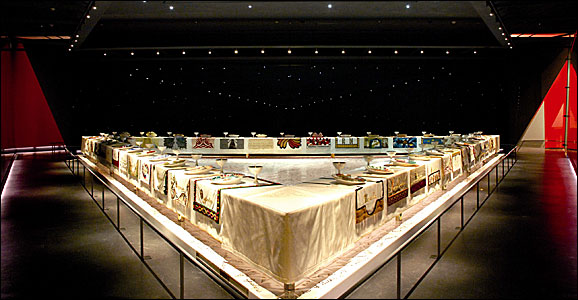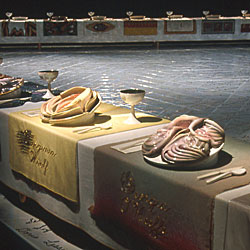Art Meets Politics: How Judy Chicago’s Dinner Party Came to Brooklyn
Art Meets Politics: How Judy Chicago’s Dinner Party Came to Brooklyn

An icon of American art, Judy Chicago’s Dinner Party is the focus of the new Elizabeth A. Sackler Center for Feminist Art at the Brooklyn Museum. The generous and elegant facility features 8,300 square feet dedicated to showing art reflecting “the core values of feminism—equality and justice.” The story of how The Dinner Party came not once, but twice to Brooklyn, exemplifies the nexus of art and politics.
The Dinner Party made its debut to great fanfare at the San Francisco Museum of Modern Art on March 15, 1979. The museum’s director, Henry Hopkins, praised the work, explaining that Chicago, with deliberate irony, had employed “women’s techniques” in a woman’s context “to create a major feminist statement.” “The overall context is universal in its impact with no sexual or historical limitations,” he added, calling it “an idea of consequence.” What the public saw was not just art, but a work that promoted the then novel idea that women had played a significant role in the history of Western civilization.
The Dinner Party’s monumental triangular table (forty-eight feet on each side) consists of three wings, the first of which runs from prehistory to Classical Rome, with place settings that begin with mythical and legendary female figures, such as Ishtar from Mesopotamia; Kali from India; the snake goddess from Crete; Sophia, whom the early Gnostic Christians worshipped as the female Holy Spirit; and the Amazon. Historical figures begin with Hatshepsut from ancient Egypt and continue through figures such as Judith from the Hebrew Bible; the lesbian poet Sappho; and Hypatia, who emulated her learned father and was brutally martyred by a Christian mob.
 Wing two continues through the Reformation, including such figures as Marcella, an early Christian; the Byzantine Empress Theodora; Petronilla de Meath (persecuted as a witch); Christine de Pisan (author of The Book of the City of Women); Elizabeth I of England; and the Italian painter Artemisia Gentileschi. The final wing stretches from the American Revolution to the women’s revolution, featuring, among others, the Native American Sacajawea, the astronomer Caroline Herschel, the abolitionist Sojourner Truth, the feminist Susan B. Anthony, the physician Elizabeth Blackwell, the poet Emily Dickinson, the composer and suffragist Ethel Smyth, birth control advocate Margaret Sanger, novelist Virginia Woolf, and artist Georgia O’Keeffe.
Wing two continues through the Reformation, including such figures as Marcella, an early Christian; the Byzantine Empress Theodora; Petronilla de Meath (persecuted as a witch); Christine de Pisan (author of The Book of the City of Women); Elizabeth I of England; and the Italian painter Artemisia Gentileschi. The final wing stretches from the American Revolution to the women’s revolution, featuring, among others, the Native American Sacajawea, the astronomer Caroline Herschel, the abolitionist Sojourner Truth, the feminist Susan B. Anthony, the physician Elizabeth Blackwell, the poet Emily Dickinson, the composer and suffragist Ethel Smyth, birth control advocate Margaret Sanger, novelist Virginia Woolf, and artist Georgia O’Keeffe.
On the heritage floor’s porcelain tiles, are 999 more names of women, distributed in relationship to each...
Subscribe now to read the full article
Online OnlyFor just $19.95 a year, get access to new issues and decades' worth of archives on our site.
|
Print + OnlineFor $35 a year, get new issues delivered to your door and access to our full online archives.
|






